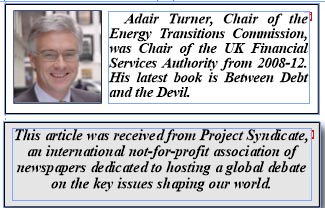
By Adair Turner
LONDON – Climate policy discussions often focus on who will bear the cost of achieving a zero carbon economy, with a particular focus on industrial sectors such as steel and cement. But the overheads are strikingly low, and our biggest challenge is our system, not industrial products.
The latest report from the UK Climate Change Committee, for example, shows that cutting the UK’s greenhouse gas emissions to net zero by 2050 would reduce Britain’s GDP by just 0.5%. The Energy Transfer Commission’s “Making Mission Possible” report estimates a similar total cost of 0.5% of global Gross Domestic Product to reduce emissions from the world’s energy, buildings, industrial and transport systems to zero by the middle of the century.
These estimates are well below those produced by older studies. Stern’s groundbreaking review of the Economics of Climate Change, published in 2006, suggested 1-1.5% of GDP costs to achieve only 80% reduction in emissions.
This welcome change reflects the dramatic and unexpected decline in costs for key technologies – with onshore wind electricity costs down 60% in just ten years, solar photovoltaic cells down more than 80%, and 85% batteries. These costs are now so low that using carbon-free products and services in many sectors will make consumers better off.
For example, the “total system costs” in the future to run nearly zero-carbon electricity systems – including all the storage and flexibility needed with unpredictable sources such as wind and solar – will often be lower than those for fossil fuel systems today. And within ten years, consumers around the world will be better off buying electric autos, paying slightly less for the vehicles and much less for the electricity that powers them than they do for the diesel and the petrol they buy today.
In some difficult-to-reduce sectors such as steel, cement and shipping, however, decarbonisation is likely to impose a significant cost. Long before 2050, carbon-free steel could be produced by using hydrogen as the reducing agent rather than charcoal coal, or by adding carbon capture and storage to traditional blast furnaces. But doing so could increase costs by 25%, or about $ 100 per ton of steel. Long-distance shipping could be powered by ammonia or methanol, but fuel costs could increase by over 100%, and freight rates by 50%. As Bill Gates puts it in his new book How to Avoid a Climate Disaster, in some sectors, we are facing a “green cost premium” against carbon emission technology today.
It is therefore essential to focus R&D and venture capital investment on innovative technologies that could lower this premium. But it is also important to recognize that even if the “green premium” lies, the cost of decarbonising these sectors will be so small that consumers will hardly notice.
Ask yourself how much steel you bought last year. Unless you are a purchasing manager, the answer is probably not direct. Instead, consumers buy steel that is incorporated into the products and services they consume indirectly – in autos, in washing machines, or in health services provided at a steel-built hospital . World Steel Association figures indicate that “actual steel consumption per capita” is 300-400 kilograms (661-882 lbs) annually in Europe and the United States. So, if the price of steel rose by $ 100 a ton, consumers would be just $ 30-40 worse off.
That negligible cost reflects the essential difference between the green premium on intermediate goods and the “green consumer premium” on end products. An increase in the price of steel by even 25% will add less than 1% to car prices. Freight rates could rise by 50%, but that would increase the price of imported clothing or food just as negligibly.
But higher costs for intermediate products are still a major policy challenge. A steel company committed to a zero carbon target will find itself severely disadvantaged if its competitors are not. Imposing a carbon price on heavy industrial sectors could overcome this problem, but only if the price is applied worldwide or combined with frontier carbon tariffs against countries that are unwilling to enforce it.
In the field of transportation, regulation by the International Maritime Organization could ensure that all companies move in stages, and the impact on consumer costs would be negligible.
By contrast, food prices and consumer food choices are trivial. Few of us buy steel directly, but everyone buys food, which even in rich countries accounts for 6-13% of total household expenditure and much more for lower income groups. For consumers, a 10% green premium for food would matter more than even a 100% premium for steel.
Furthermore, in the food sector, meat production is highly emission intensive. Methane emissions from livestock and manure have a global warming effect that exceeds the three gigatons of carbon dioxide from steel production, and five additional gigatons of CO2 result from land-use changes, such as when a forest be transformed into soybean production for cattle feed.
Here, too, technological solutions may be possible, but major challenges remain. Consumers do not care about the specific character of the steel they consume indirectly, but beef eaters have strong opinions about the texture and taste of steak, which synthetic meat production may not repeat. And while the green premium for synthetic meat over animal meat is falling, it must go near zero to avoid a significant impact on consumer budgets.
This could change, however, if people decided they would be happy with less meat and more dense vegetables, which would also cost less. In that case, food could become like road transport, with consumers benefiting from the transition to zero carbon rather than facing a cost burden.
Copyright: Project Syndicate, 2021.
www.project-syndicate.org